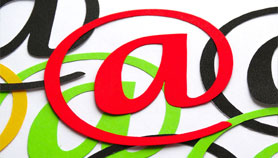

J&C Blog
Find all the latest marketing trends on the J&C Blog.

Find all the latest marketing trends on the J&C Blog.

OK, I admit it. My only wish is to be able to tell marketers when their “personalized emails” are, in fact, not personal at all. This bold statement is not based solely on the fact that most marketers will say they are doing something when in truth they are lacking in the execution. Rather, my frustration stems from the fact that most people who say they are already personalizing emails are basically telling me that they see no value in optimization. They are already closed off to any possibility of improvement.
Take, for example, this recent response I received from a retail marketer: “We’re already doing personalized email, so we wouldn’t need any information in that area.” Keep in mind that I was contacting this prospect with free information on the best techniques to optimize personalized email. Working in new business for a marketing agency, I know the importance of optimizing marketing activities to improve performance. The cold hard truth is that most marketers think they are executing personalized email, but in reality they aren’t optimizing the opportunities for personalization that are readily available to them. Here are some common misperceptions that I’ve seen from marketers regarding personalized emails and possible opportunities for optimization.
1. “Yes, we personalize our emails. I mean, we put the customers’ names in the emails we send out.”
Personalization is more than putting someone’s name on an email. Let’s face it: A lot of marketers put a name on their emails and say that they are executing personalization, but that’s not even close. A recent Jacobs & Clevenger study showed 2 out of 3 consumers preferred to receive personalized email from marketers.1 Specifically, the study revealed that:
Notice that putting the customer’s name on the email wasn’t even mentioned. That is an expectation that must be met automatically. If you don’t, customers most likely won’t even bother to look at this attempt at email communications. An optimization opportunity would be for marketers to tap into their CRM database and link to that valuable information at an individual level when crafting personalized emails. Loyalty programs and other related techniques that track consumer activities and behavior should be leveraged to optimize personalization. To learn more about the stats and techniques that aid in effectively personalizing consumer communications, download the full Jacobs & Clevenger 2013 Retail Communication Preferences Study.
2. “We send out personalized emails to special groups of customers.”
Uh… would that be a reference to segmentation? That sounds like a step in the right direction and hints at optimization; however, segmentation is only one aspect and should be incorporated where applicable to help with personalization to improve performance.
Simply sending to a group of customers who have shown an interest in, say wedding products, doesn’t translate to personalization. Knowing which wedding products the customers have shown interest in, which they’ve already purchased or are planning to purchase, should also be included in their personalized email. Have they started a gift registry? If so, what is the activity from that? And what other products could be suggested for them to add to their list? This is the path to optimizing personalization with segmentation.
3. “We send personalized emails with special sales and event notifications to our customers.”
I’ve heard this over and over. Unfortunately, it turns out those special sales and event notifications usually are nothing more than a regurgitated version of the current advertised sale or event that everyone in the general public receives. A way to personalize this aspect would be to actually have a special sale or event that is exclusive to a segment or group of customers. Again, that special sale or event should be relevant to the personal interests of the recipients. For that group interested in wedding products, for example, an email inviting them to a special sale or event for wedding products could be sent with a personalized mention regarding items of interest to each individual and their interests.
This is also a good topic for loyalty program data to come into play. Customers who belong to loyalty programs are looking for exclusive invites and special offers. The information obtained when they signed up for the program, along with the data from their ongoing participation, all provide personalized data that can easily be incorporated into email communications.
4. “We send personalized emails to our customers 3 or 4 times a week.”
First, let’s be clear: Frequency does not translate to personalization. Truly personalized emails should only be sent when the topic is relevant to the individual’s preferences and behavior. Individual behavior should be monitored as to how and when consumers engage with your brand. These analytics can then be applied to future personalized email messages, incorporating information specific to each individual. Optimizing this process will produce greater response from your personalization efforts.
Optimizing personalization involves a very detailed and analytical approach to existing data, behavior, preferences and strategy. Incorporating past purchases, interactions and various touchpoints that a consumer has with a brand into future communications is key. The optimization of personalized emails can have a huge impact on the success of your initiative. For additional information on the impact of personalizing email, please see our article Impact of personalizing email.
Remember, personalization is a different topic from, say, mass emails, which should never be considered personalized or even mentioned in the same sentence, for that matter. Knowing how to leverage data and list segmentation is crucial to producing successful email marketing campaigns. To learn more proven ways to optimize your email marketing programs, sign up for J&C’s email marketing assessment. This free assessment will cover effective techniques for optimizing your email marketing and how they can be incorporated into your current email marketing strategy to ensure campaign success.
Topics: Best Practices, Email Marketing
303 E Wacker Drive, Suite 2030
Chicago, IL 60601
Phone: 312-894-3000
Fax: 312-894-3005